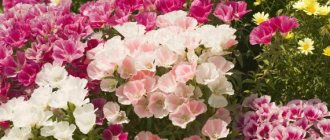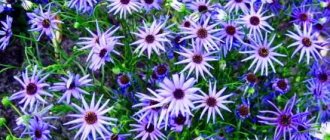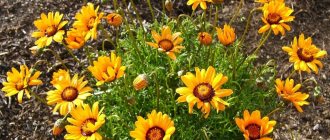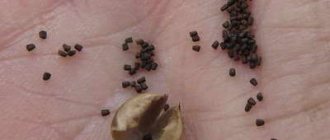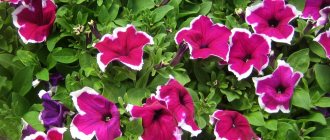Daisies are beautiful, romantic flowers that are often preferred by gardeners to decorate their garden landscapes.
Large garden daisies are easy to grow, they do not require special care and are perennial plants - which is not an ideal option for decorating your favorite garden. But before you grow a herbaceous plant, it doesn’t hurt to familiarize yourself with the basic conditions for growing healthy and flowering daisies.
Description of garden perennial chamomile
The brightest large-flowered plants are used to decorate flower beds.
Flower growers first became interested in daisies more than two hundred years ago, so many cultivated varieties have appeared over the years. And although perennial garden daisies can be of different heights, have different flowering times and inflorescence shapes, all daisies have much in common. First of all, this is a recognizable form of an inflorescence-basket, the core of which consists of small tubular yellow flowers, and the frame is made of false-ligulate petals.
Today, thanks to the efforts of breeders, semi- and double varieties of garden chamomile are available to gardeners.
Compared to wild specimens in cultivated perennials:
- flowers are larger;
- bud formation is much more active;
- the flowering period is longer;
- flowers may reappear in the second half of summer.
In early spring, a rosette of oblong basal leaves appears above the soil. When inflorescences appear on faceted, erect stems, the height of the plant can vary from 20 to 80 cm. Depending on the variety, the diameter of the inflorescences can reach from 3 to 10 cm.
Varieties of daisies
Matricaria is a representative of flowering plants from the family Asteraceae, or Asteraceae. It is a perennial. Flowers grow wild in meadows, and their cultivated representatives decorate flower beds in gardens.
These include about 20 varieties of low-growing aromatic herbs. Plants begin to bloom within the first year of their life. Flowering begins 30-50 days after the appearance of the very first shoots.
Many plants of other genera from the Asteraceae family are called daisies. But they all only have an external resemblance to the matrikarium. Wildflowers do not have such a chic and attractive appearance as cultivated ones.
Flowers that belong to daisies include:
- asters;
- gerberas;
- heliopsis sunflower;
- doronicuma;
- common and greatest cornflower;
- osteospermum;
- pyrethrum rosea;
- navels;
- Echinacea purpurea;
- three-ribs;
- autumn chrysanthemums.
Their basket inflorescences are endowed with marginal reed flowers. They may have white or another shade of petals. The central place of the inflorescence is always the darkest. Plant leaves have completely different shapes. From a botanical point of view, calling them daisies is a mistake.
These herbs are often used in decorative floriculture. They have a very attractive appearance, which is why they are widely used in the design of city flower beds.
These plants are not very demanding on the soil. They prefer well-lit places. If plants are planted in a darkened area, they will have small flowers and poor flowering.
Chamomiles are bred as seedlings for flowerbeds and flowerbeds in greenhouses, as they are not resistant to frost. These herbs withstand transplantation remarkably well.
The distance between sprouts should be:
- at least 30 cm for tall species;
- 20-25 cm for medium-sized flowers;
- 15-20 cm for low-growing plants.
To create bouquets, daisies are cultivated in flowerbeds. Low-growing types of flowers take root well in pots. In most cases, they are used to decorate borders.
In order for plants to please the eye for a longer time, it is necessary to systematically remove fading inflorescences.
Approximately once every 5 years it is necessary to renew the planted bushes. Otherwise, the ornamental plant is degenerated. It's starting to look pretty much like something growing wild. In some cases, it can even take on the appearance of a weed.
Some of them (for example, Echinacea purpurea) are wonderful medicines.
Growing chamomile from seeds
Sowing chamomile
Growing chamomile is possible in seedlings and without seedlings. You can sow garden chamomile seeds simply in the ground, but it is safer to use the seedling method.
Chamomile seeds are sown for seedlings in March. Trays with cells are filled with a moist, light, breathable substrate consisting of peat and sand in equal parts, 2-3 seeds are placed in each cell, sprinkled with a thin layer of substrate on top, the container is covered with a transparent film and placed close to the window, but not on window sill, since the light passing through the glass is too intense and can damage the seed germination process. Monitor the condition of the soil, and as soon as it dries, moisten it with a spray bottle.
Chamomile seedlings
When the seedlings begin to appear, and at normal room temperature this will happen in one and a half to two weeks, remove the film and place the container as close to a sunny window as possible, protecting the seedlings from drafts. If this is not possible for any reason, place a fluorescent lamp over the container, which should work for at least 14 hours a day. As soon as the chamomile seedlings reach a height of 5 cm, leave only one, the most developed seedling, in each cell.
Do not pull out unnecessary seedlings, but carefully pinch them off above the soil surface, because you risk damaging the root system of the remaining seedling. In order for chamomile to bush, pinch it over 3-4 leaves.
When do daisies bloom?
In general, chamomile is a summer flower that blooms almost all summer. Chamomile begins to bloom around mid-June and ends blooming in September , when Indian summer ends.
Every girl will probably be pleased to receive a bouquet of simple field daisies as a sign of attention. In winter and even in spring, we can only dream that in the summer someone will give them to us. Well, as a last resort, what to wait. Go out into the street or into the field and admire, enjoy and guess, I don’t want to from the second half of June) Last year I was pleased to see a chamomile at the end of September, at the beginning of October)
Chamomiles are wild flowers. There are artificially grown daisies in greenhouses - these bloom all year round. And there is chamomile, which blooms in the second half of June and continues to bloom until the end of summer.
Flowering in daisies begins 30-50 days immediately after the appearance of the first shoots.
My friend's birthday is July 20, and according to a long-standing tradition, I give her a bouquet of daisies. They bloom just at this time. In general, I think it all depends on the region; somewhere they may bloom earlier. For example, our lilac has just bloomed.
Field chamomile begins to bloom in mid-June. Peak flowering occurs in July. Such beauty is indescribable: daisies, cornflowers and ears of wheat mixed together :) I always collect and dry chamomile, as well as cornflowers at this time. Then I mix some of it with black or green tea, making this healing assortment



